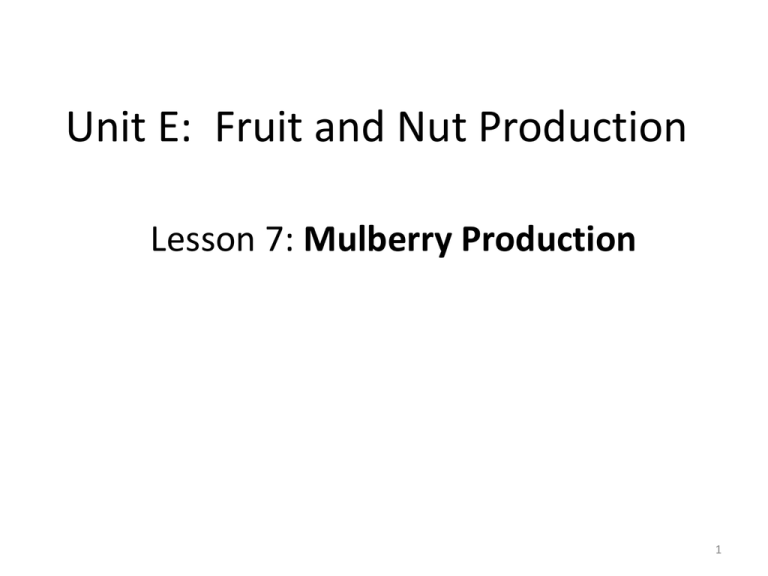MulberryProduction-English
advertisement

Unit E: Fruit and Nut Production Lesson 7: Mulberry Production 1 Terms • dioecious • monoecious • catkins 2 I. There are 10 to 16 different species of the Morus genus. 3 A. Black mulberries (Morus nigra) originated in Southwest Asia. 1. It is a small deciduous tree growing to 10–13 meters tall. 2. The edible fruit is dark purple, almost black, when ripe, 2–3 centimeters long. 4 B. White mulberry (Morus alba) originated in East Asia. 1. It can grow 10-20 meters tall and bear fruit that is about 1 to 2.5 centimeters long. 2. This species is very important in China for the production of silk. 5 6 C. Red mulberry (Morus rubra) originated in eastern North America. 1. This tree can grow 10 to 15 meters tall bearing fruit 23 centimeters long with a resemblance to blackberries. 7 D. Russian Mulberry (Morus alba var. tatarica) is a variation of white mulberry. 1. These trees grow 9 to 15 meters tall. 2. The fruit can range in color from red to white. 8 E. The berries can be eaten out of hand or used in any way that other berries are used, such as in pies, tarts, puddings or sweetened and pureed as a sauce. 1. Slightly unripe fruits are best for making pies and tarts. 2. Mulberries blend well with other fruits, especially pears and apples. 3. They can also be made into wine and make an excellent dried fruit, especially the black varieties. 9 F. Mulberries are not commonly grown for commercial production in Afghanistan. 1. The majority of mulberries are planted for dry and fresh use. 2. The trees are mostly planted around the edges of fields as a border. 10 11 II. Mulberries are very easy to grow and in most cases require very little care. A. All three mulberry species are deciduous trees of varying sizes. 1. White mulberries can grow to 24 meters and are the most variable in form, including drooping and pyramidal shapes. 2. The red mulberry can reach 21 meters in height. 3. The black mulberry is the smallest of the three, sometimes growing to 9 meters in height, but it tends to be a bush if not trained when it is young. 12 B. The species vary greatly in longevity. 1. Red mulberry trees rarely live more than 75 years, while black mulberries have been known to bear fruit for hundreds of years. 2. The mulberry makes an attractive tree which will bear fruit while still small and young. 13 C. Mulberry trees are either dioecious, meaning male and female flowers are on separate trees, or monoecious, meaning male and female flowers are on the same tree, and sometimes will change from one sex to another. 1. The flowers are held on slim cylindrical, flower clusters called catkins that appear in the axils of the current season's growth and on spurs on older wood. 2. Mulberries are wind pollinated and some cultivars will set fruit without any pollination. 3. Cross-pollination is not necessary. 14 15 D. Botanically the fruit is not a berry but a collective fruit, which looks like a blackberry. 1. When the flowers are pollinated, they and their fleshy bases begin to swell. 2. Ultimately they become completely altered in texture and color, becoming succulent, fat and full of juice. 3. In appearance, each tiny swollen flower roughly resembles the individual drupe of a blackberry. 16 4. The color of the fruit does not identify the mulberry species. a. White mulberries, for example, can produce white, lavender or black fruit. b. White mulberry fruits are generally very sweet but often lacking in needed tartness. c. Red mulberry fruits are usually deep red, almost black, and in the best clones have a flavor that almost equals that of the black mulberry. 17 d. Black mulberry fruits are large and juicy with a good balance of sweetness and tartness that makes them the best flavored species of mulberry. e. The refreshing tart taste is in some ways reminiscent of grapefruit. f. Mulberries ripen over an extended period of time unlike many other fruits which seem to come all at once. 18 III. Mulberries need full sun and also adequate space. A. The distance between trees should be at least 4.5 meters. 1. The trees are quite wind-resistant with some cultivars used as windbreaks. B. Mulberries like a warm, well-drained soil, preferably a deep loam. 1. Shallow soils such as those frequently found on gravel are not recommended. 19 C. Although somewhat droughtresistant, mulberries need to be watered in dry seasons. 1. If the roots become too dry during drought, the fruit is likely to drop before it has fully ripened. D. Mulberries generally thrive with minimal fertilization. 1. An annual application of a balanced fertilizer such as 10:10:10 NPK will maintain satisfactory growth. 20 E. No special pruning techniques are needed after the branches have been trained to a sturdy framework, except to remove dead or overcrowded wood. 1. A mulberry tree can be kept to a tidy form by developing a set of main branches, and then pruning laterals to 6 leaves in July in order to develop spurs near the main branches. 2. It is not advisable to prune the trees heavily since the plant is inclined to bleed at the cuts. 3. Cuts of more than one centimeter in diameter generally do not heal and should be avoided at all cost. 4. The bleeding will be less severe if the tree is pruned while it is dormant. 21 F. Mulberries can be grown from seed, although the plants can take 10 years or more to bear. 1. Seed should be sown as soon as extracted from the fruit, although white mulberry seeds germinate better after stratifying one to three months before planting. 2. Sprig budding is the most common method for grafting mulberries. a. A T-cut is made in the rootstock and a smooth, sloping cut is made on the lower end of the scion. b. The scion is then inserted into the T and wrapped and sealed. 22 3. Other types of grafts are also usually successful, although there may be incompatibility between white and black mulberries. a. Hardwood, softwood and root cuttings also are suitable methods for propagating mulberries. b. Softwood cuttings of white mulberries root easily when taken in midsummer and treated with rooting hormone. c. Red mulberries are less easily rooted. d. Black mulberries are also somewhat difficult to propagate since they tend to bleed a lot. 23 G. Mulberries are generally free of pests and diseases, although cankers and dieback can occur. 1. In some areas "popcorn disease" is an occasional problem, in which fruits swell to resemble popped corn. 2. M. alba and M. rubra hybrids are particularly prone to this condition. 3. The disease carries on from one season to the next, so collecting and burning infected fruits help control it. 4. The ripe fruit is very attractive to birds, but there is usually enough fruit left over for harvesting. 24 IV. White and red mulberry fruits (and hybrid fruits) are ready for harvest in late spring. A. The fruit of black mulberries ripen in summer to late summer. B. The fruits of white mulberries are often harvested by spreading a sheet on the ground and shaking the limbs. C. A surprising quantity can be gathered from a comparatively small and young tree. 25 1. Black mulberry fruits are more difficult to pick. a. As the berries are squeezed to pull them loose, they tend to collapse, staining the hands (and clothing) with blood red juice. 2. Unwashed the berries will keep several days in a refrigerator in a covered container. 26 Review/Summary 1. Where did Morus originate? 2. How do mulberries reproduce? 3. What growing conditions are needed for mulberries? 4. What is the best way to harvest mulberry? 27







